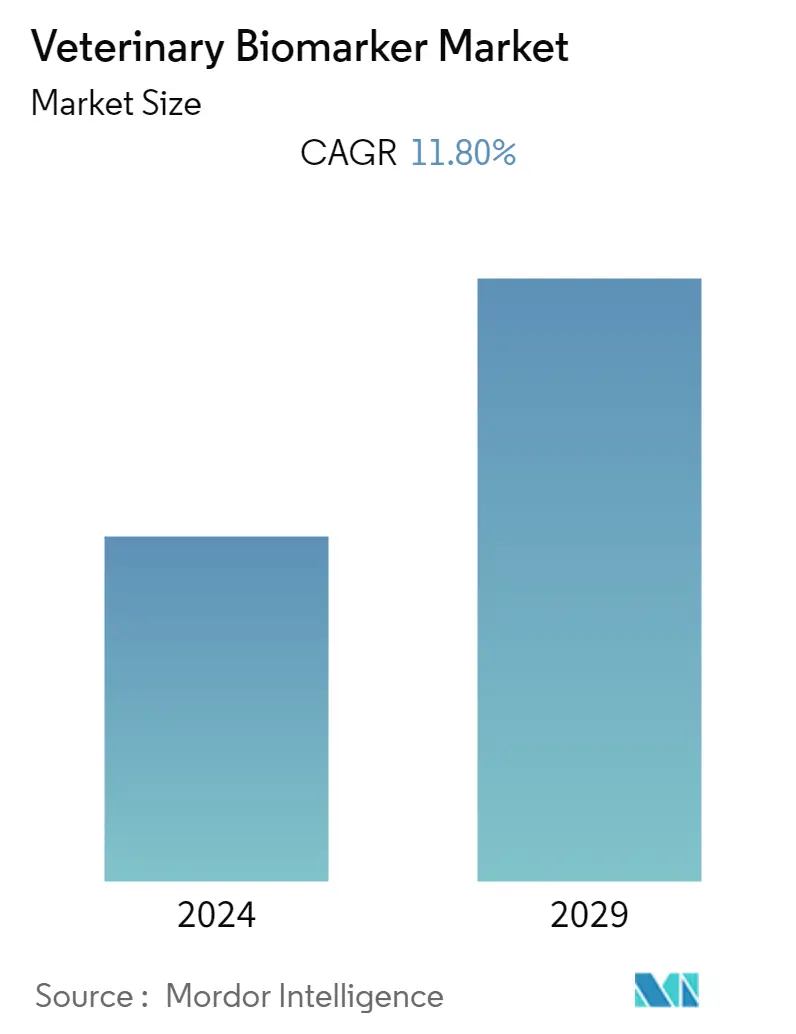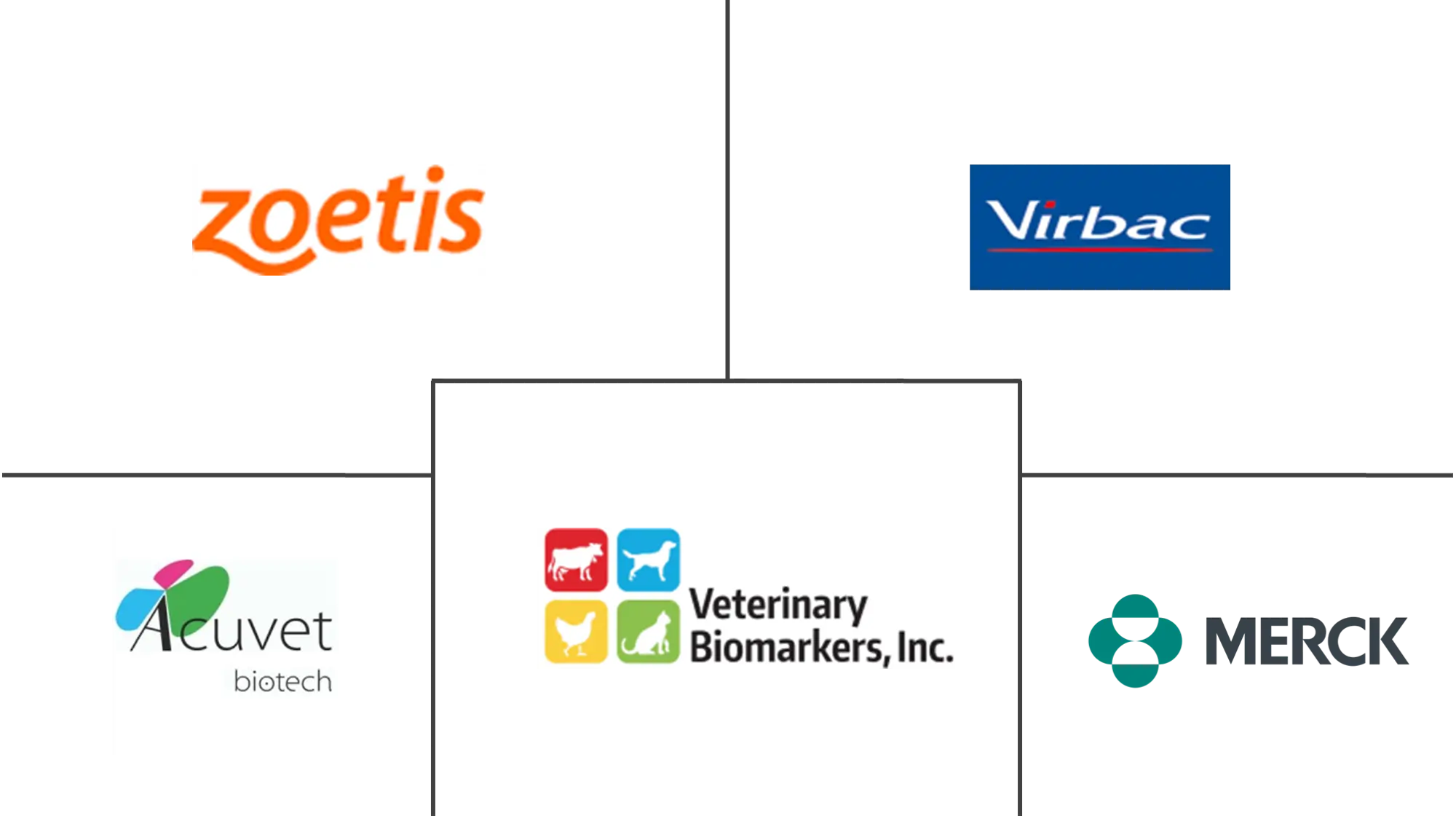Market Size of Veterinary Biomarker Industry

| Study Period | 2019 - 2029 |
| Base Year For Estimation | 2023 |
| CAGR | 11.80 % |
| Fastest Growing Market | Asia-Pacific |
| Largest Market | North America |
| Market Concentration | Medium |
Major Players
*Disclaimer: Major Players sorted in no particular order |
Veterinary Biomarker Market Analysis
The veterinary biomarker market is expected to register a CAGR of 11.8% over the forecast period.
The COVID-19 pandemic initially had a substantial impact on the veterinary biomarker market. The strict lockdowns and government regulations intended to slow down the spread of COVID-19 resulted in limited access to veterinary services. As per the study conducted by Merck Animal Health, a division of Merck & Co., Inc., in January 2022, the pandemic impacted many veterinarians, such as veterinary assistants, veterinary technicians, and practice managers, resulting in more than 90% of the shortage of qualified veterinary staff. Also, the pandemic caused severe mental distress amongst veterinarians, which rose from 6.4% in 2019 to 9.7% in 2021, as per the readings from Kessler Psychological Distress Scale, negatively impacting the market growth. However, the sales of veterinary products increased significantly during the pandemic. For instance, as per the American Veterinary Medical Association in August 2021, veterinary services showed a significant increase during the pandemic owing to a surge in the adoption of pets. Also, the pet owners were procuring higher-value veterinary products. Thus, the COVID-19 outbreak affected the market's growth adversely in its preliminary phase; however, the market is expected to gain traction due to the significant increase in the procurement of veterinary products globally.
Further, the high prevalence of chronic diseases such as cardiovascular diseases and cancer in animals, the high adoption rate, and the burgeoning population of companion animals are certain factors that are boosting the market growth. As per the American Veterinary Medical Association in April 2022, purebred dogs had 1.9 times higher relative risk of cancer in comparison to non-purebred dogs. In veterinary oncology, biomarkers are used for diagnosis, prognosis, staging, and tracking therapeutic outcomes. Such factors are likely to boost the adoption of veterinary biomarkers, thereby contributing to the growth of the market studied.
Moreover, the market for veterinary biomarkers is also expanding due to factors including the rising pet adoption rates and the expanding population of companion animals. For instance, as per the 2021-2022 American Pet Products Association (APPA) National Pet Owners Survey, approximately 70% of United States households own a pet, which equates to 90.5 million homes. Therefore, the increasing number of companion pet adoption is augmenting the demand for the veterinary biomarkers market.
Therefore, owing to the aforementioned factors, the market studied is anticipated to witness growth over the analysis period. However, the increasing pet care costs are likely to impede the market growth.
Veterinary Biomarker Industry Segmentation
Biomarkers are significantly used in animals for diagnosing a particular disease, evaluating their health status, and monitoring therapy response.
The veterinary biomarker market is segmented by Animal Type (Companion Animals (Dogs, Cats, and Other Companion Animals) and Farm Animals (Cows, Pigs, and Other Farm Animals), Product Type (Biomarkers, Kits & Reagents, and Biomarker Readers), Application (Disease Diagnostics, Preclinical Research, and Other Applications), Disease Type (Inflammatory & Infectious Diseases, Cardiovascular Diseases, Skeletal Muscle Diseases, Tumors, and Other Disease Types), and Geography (North America (United States, Canada, and Mexico), Europe (Germany, United Kingdom, France, Italy, Spain, and Rest of Europe), Asia-Pacific (China, Japan, India, Australia, South Korea, and Rest of Asia-Pacific), Middle East and Africa GCC, South Africa, and Rest of Middle East and Africa), and South America (Brazil, Argentina, and Rest of South America)). The market report also covers the estimated market sizes and trends for 17 countries across major global regions. The report offers the value (in USD million) for the above segments.
| By Animal Type | |||||
| |||||
|
| By Product Type | |
| Biomarkers, Kits & Reagents | |
| Biomarker Readers |
| By Application | |
| Disease Diagnostics | |
| Preclinical Research | |
| Other Applications |
| By Disease Type | |
| Inflammatory & Infectious Diseases | |
| Cardiovascular Diseases | |
| Skeletal Muscle Diseases | |
| Tumors | |
| Other Disease Types |
| By Geography | ||||||||
| ||||||||
| ||||||||
| ||||||||
| ||||||||
|
Veterinary Biomarker Market Size Summary
The veterinary biomarker market is poised for significant growth, driven by factors such as the increasing prevalence of chronic diseases in animals, the high adoption rate of companion animals, and the expanding pet population. The market experienced initial setbacks due to the COVID-19 pandemic, which restricted access to veterinary services and caused a shortage of qualified veterinary staff. However, the pandemic also led to a surge in pet adoption and increased demand for veterinary products, which has since bolstered market growth. The adoption of biomarkers for diagnosing and treating diseases in animals is revolutionizing veterinary practice, with continuous product launches by major players further propelling the market forward. Despite the challenges posed by rising pet care costs, the market is expected to witness robust expansion over the forecast period.
North America is anticipated to dominate the veterinary biomarker market, supported by high companion animal adoption rates and substantial annual expenditure on pet care. The United States, in particular, is a key contributor to regional growth, with a significant number of veterinarians and veterinary specialty organizations. The increasing adoption of pet insurance services in North America, which covers veterinary treatments and medications, is also expected to enhance market growth. The competitive landscape of the market is fragmented, with several global and regional companies, including Zoetis Inc., Virbac, and Merck & Co., Inc., holding significant market shares. These companies are actively involved in expanding their product offerings and enhancing production capabilities, contributing to the overall growth of the veterinary biomarker market.
Veterinary Biomarker Market Size - Table of Contents
-
1. MARKET DYNAMICS
-
1.1 Market Overview
-
1.2 Market Drivers
-
1.2.1 High Prevalence of Chronic Diseases in Animals
-
1.2.2 Implementation of Innovative R&D Strategies by Prominent Players
-
1.2.3 Rising Pet Adoption Rates
-
-
1.3 Market Restraints
-
1.3.1 Expanding Pet Care Costs
-
-
1.4 Porter's Five Forces Analysis
-
1.4.1 Threat of New Entrants
-
1.4.2 Bargaining Power of Buyers/Consumers
-
1.4.3 Bargaining Power of Suppliers
-
1.4.4 Threat of Substitute Products
-
1.4.5 Intensity of Competitive Rivalry
-
-
-
2. MARKET SEGMENTATION (Market Size by Value in USD million)
-
2.1 By Animal Type
-
2.1.1 Companion Animals
-
2.1.1.1 Dogs
-
2.1.1.2 Cats
-
2.1.1.3 Other Companion Animals
-
-
2.1.2 Farm Animals
-
2.1.2.1 Cows
-
2.1.2.2 Pigs
-
2.1.2.3 Other Farm Animals
-
-
-
2.2 By Product Type
-
2.2.1 Biomarkers, Kits & Reagents
-
2.2.2 Biomarker Readers
-
-
2.3 By Application
-
2.3.1 Disease Diagnostics
-
2.3.2 Preclinical Research
-
2.3.3 Other Applications
-
-
2.4 By Disease Type
-
2.4.1 Inflammatory & Infectious Diseases
-
2.4.2 Cardiovascular Diseases
-
2.4.3 Skeletal Muscle Diseases
-
2.4.4 Tumors
-
2.4.5 Other Disease Types
-
-
2.5 By Geography
-
2.5.1 North America
-
2.5.1.1 United States
-
2.5.1.2 Canada
-
2.5.1.3 Mexico
-
-
2.5.2 Europe
-
2.5.2.1 Germany
-
2.5.2.2 United Kingdom
-
2.5.2.3 France
-
2.5.2.4 Italy
-
2.5.2.5 Spain
-
2.5.2.6 Rest of Europe
-
-
2.5.3 Asia-Pacific
-
2.5.3.1 China
-
2.5.3.2 Japan
-
2.5.3.3 India
-
2.5.3.4 Australia
-
2.5.3.5 South Korea
-
2.5.3.6 Rest of Asia-Pacific
-
-
2.5.4 Middle East and Africa
-
2.5.4.1 GCC
-
2.5.4.2 South Africa
-
2.5.4.3 Rest of Middle East and Africa
-
-
2.5.5 South America
-
2.5.5.1 Brazil
-
2.5.5.2 Argentina
-
2.5.5.3 Rest of South America
-
-
-
Veterinary Biomarker Market Size FAQs
What is the current Veterinary Biomarker Market size?
The Veterinary Biomarker Market is projected to register a CAGR of 11.80% during the forecast period (2024-2029)
Who are the key players in Veterinary Biomarker Market?
Zoetis Inc. , Virbac, Veterinary Biomarkers, Inc., ACUVET BIOTECH and Merck & Co., Inc. are the major companies operating in the Veterinary Biomarker Market.

